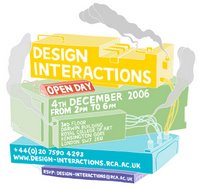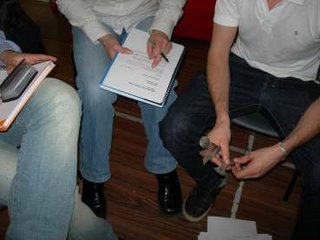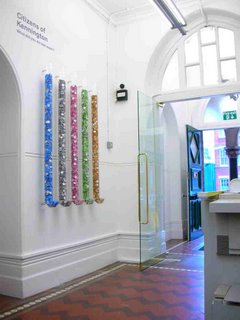For the details of the conference, see the Design Management Institute's website (link below), and see also Ralf Beuker's blog on his workshop there and the issues raised at
www.design-management.de.
As is typical at conferences involving both practitioners and academics, the conversations were taking place at several levels. Some people were telling stories about their practices; others were refering to or defining models and building directly on an evolving and transferable body of knowledge. As a relative newcomer to this conversation with a practitioner background, I was glad to have an opportunity to hear different positions articulated and to meet some interesting, thoughtful people. As I understood it, the conference was trying to mark out different models of design leadership and their implications, within the terms of reference of the organizing body, the DMI, whose vision is to "improve organizations worldwide through the effective management of design for economic growth".
Leaving aside for the moment the ends to which design management, or indeed design leadership, might be put, I'd like to repeat some the key issues I heard raised at the event:
- The desire of designers to be taken more seriously/have their value understood/have a seat on the board; or the claim that this is already so (design as function; the strategic role of design).
- The question of how to export to other domains designers' approaches, practices, methods and tools (often characterized as 'design thinking' - potentially a kind of design leadership).
- The question of whether designers want to own 'creativity' within organizations. If managers and entrepreneurs work in reflexive, iterative, conceptual, creative ways, and make use of design thinking where relevant, does this need to be labelled 'design leadership' or could it just be 'leadership'?
- The problems created by the language of some designers, and by much of design education, which serves to keep non-designers out.
- The argument that people involved in design management (practitioners in design and client organizaions, and academics researching and teaching in this area) are mostly talking to themselves; that management and change management consultants, for example, are already adopting some of the practices of designers (but not calling it design) and may step up to the challenge of further disseminating them before designers and design educators do.
What was missing for me was the following
- Acknowledgement of emerging areas of design within organizational contexts in particular service design, interaction design and experience design. The services sector now accounts for 70% of many advanced industrial economies (UNCTAD, 2004, World Investment Report: The Shift Towards Services). But the conference emphasis was on branding, communications and product design which are, more or less, solved problems and certainly well-framed problems.
- Greater acknowledgement of non-corporate contexts for design including the public sector and the growing area of social entrepreneurship, covered for example through a detailed case study presentation, rather than mentioned only within the context of one academic paper. See for example the research work of the
UK Design Council's RED unit, and the
Skoll Centre for Social Entrepreneurship, part of the institution where I work.
- A deeper discussion about the limits to design leadership. Could design leadership create an effective response to a disaster or emergency? Could it lead to a coherent policy within Europe on handling asylum seekers? Could design leadership, rather than other kinds of leadership, lead to sustainable innovation in the involvement of citizens in democratic processes?
Clearly some of these issues challenge the DMI's vision of using design management to improve economic growth but a case could be made for their inclusion, or at least their consideration, within this framework.
















